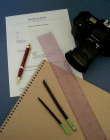 Portrait painting is a creative process that requires careful planning and close consultation between the artist and the client commissioning the portrait. During initial consultation the size and basic composition of the work are discussed. Key elements, such as lighting, background, location, and expression, are carefully considered. The artist makes preliminary sketches and takes reference photographs. All this is done in a relaxed, informal atmosphere, either at your home or business, or at the artist's studio.
Portrait painting is a creative process that requires careful planning and close consultation between the artist and the client commissioning the portrait. During initial consultation the size and basic composition of the work are discussed. Key elements, such as lighting, background, location, and expression, are carefully considered. The artist makes preliminary sketches and takes reference photographs. All this is done in a relaxed, informal atmosphere, either at your home or business, or at the artist's studio.
 Although painting from life has advantages, clients generally prefer not to spend many hours in several sessions sitting for a portrait. For this reason, the actual painting of the canvas is done in the artist's studio using the preliminary sketches and selected reference photographs. Head-and-shoulders portraits usually are completed within a couple of months; larger and more detailed works take longer. If necessary, minor adjustments can be made before the portrait is framed.
Although painting from life has advantages, clients generally prefer not to spend many hours in several sessions sitting for a portrait. For this reason, the actual painting of the canvas is done in the artist's studio using the preliminary sketches and selected reference photographs. Head-and-shoulders portraits usually are completed within a couple of months; larger and more detailed works take longer. If necessary, minor adjustments can be made before the portrait is framed.
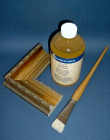 The finished work can be delivered framed and ready to hang. Or you can choose to have the portrait framed yourself. In order to preserve your fine-art portrait, the surface should be protected with a museum-quality archival varnish. To prevent cracking, archival varnish is applied only after the paint has thoroughly cured (usually about 9 to 12 months). By returning your portrait to the artist for varnishing, you will be protecting and preserving the work for posterity as a valuable heirloom.
The finished work can be delivered framed and ready to hang. Or you can choose to have the portrait framed yourself. In order to preserve your fine-art portrait, the surface should be protected with a museum-quality archival varnish. To prevent cracking, archival varnish is applied only after the paint has thoroughly cured (usually about 9 to 12 months). By returning your portrait to the artist for varnishing, you will be protecting and preserving the work for posterity as a valuable heirloom.
For answers to questions you may have on the portrait process, please check the FAQ section.
Here is an excerpt from the article on Commissioned Portraiture in the May 2006 issue of Fine Art Connoisseur:
"For most people, sitting for a painted portrait is a once-in-a-lifetime occurrence. You can guarantee a great experience and a satisfying finished portrait by taking the time to research the perfect artist for your needs, and by approaching the event as a collaboration with the artist. You'll be left with a beautiful work of art that will be enjoyed for generations to come."
This section demonstrates the master portrait technique used by Dave Turner. The sequence of pictures shows some of the main steps in a work from the Original Portraits gallery, using a 20" x 16" linen canvas.
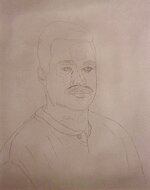
On the primed canvas, a light charcoal contour sketch defines the layout of the composition. Careful attention is given to accuracy of line and proportion, in order for the portrait to be a true likeness of the subject.
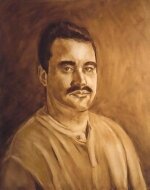
The underpainting is a fairly detailed portrait in monochrome. Pigment is applied thinly. This stage completes the foundation, with form and space defined by light, dark and halftone values.
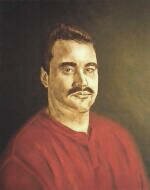
After the underpainting has dried, basic colors for the background and subject's clothes are blocked in. These colors will affect the flesh tones applied subsequently.
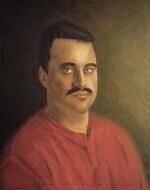
The portrait is rendered as a series of semi-transparent layers. These glazes give the flesh a luminous quality that is unique to the oil medium and a hallmark of the Old Masters' fine-art technique.
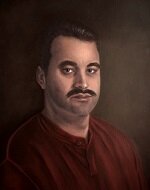
After further glazing the flesh, background and garments, highlights and details are added. Compared to the carefully controlled brushwork of earlier stages, finishing touches are executed with lively strokes.
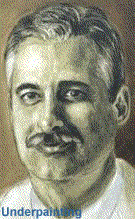
Early Italian renaissance painters portrayed rich color and luminous atmosphere by the use of oil glazes. Instead of mixing color on the palette, pure colors were applied to the canvas in a sequence of separate, thin, transparent layers, producing a combined chromatic effect.
In the 16th century, Titian introduced mixed, or 'broken,' colors. These colors also can be applied as glazes, with glowing results. Titian is said to have applied dozens of glazes to some of his paintings.
Glazing was a traditional part of the academic painting process for centuries. The technique was used extensively by master painters until the end of the nineteenth century, when French Impressionists employed the 'direct' painting method to immediately capture the transitory effects of daylight. Although glazing is slower than direct painting, this Old Master technique is unmatched for luminous color.
This section demonstrates the Venetian technique used by the artist to produce a copy of Bronzino's "Lady in a Red Dress." For a description of the finished work, see the Portrait Reproductions gallery.
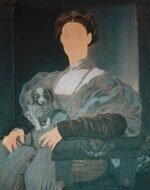
The canvas is primed with a light imprimatura of Venetian red, over which the drawing is laid. Except for the flesh, the entire picture is underpainted in monochrome, establishing the appropriate light and dark values that are later glazed with color.
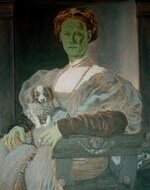
Chromium oxide of green is used as the base color for the subject's head and hands. This green underpainting is ideal for producing the olive undertones typical of Italian complexion.
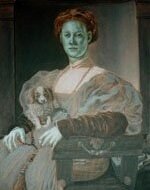
Over the green underpainting, the head and hands are modeled by dry brushing the highlight areas with white paint. By lightly scumbling the halftone areas, the green underpainting shows through the white.
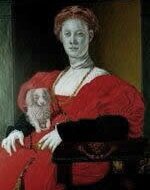
Color is applied to the background, chair, and garments with a series of semi-transparent layers. Each color glaze has the same value as the monochrome underpainting.
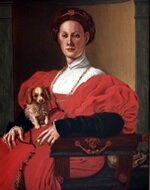
After rendering the lap dog and the subject's hair, the face and hands are repeatedly glazed to a level of detail similar to Bronzino's original. These glazes give life to the flesh and complete the portrait.
This section presents a more detailed demonstration of Dave Turner's painting technique, featuring a commissioned copy of "Morning Bouquet" by French artist Alfred Guillou (1844-1926) who worked in the atelier of William Bouguereau.
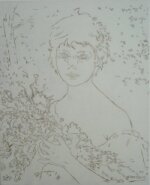
After applying coats of acrylic gesso and white oil paint to a 20" x 16" linen canvas, a drawing of the original painting was transferred to the canvas and outlined with a thin mixture of burnt umber and titanium white, using a fine sable brush.
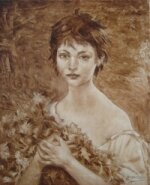
Burnt umber and titanium white also were used for this initial rough-in, establishing approximate values for the grayscale underpainting to follow.
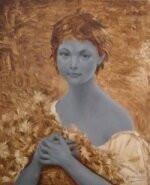
Working from dark to light, an underpainting is begun using values of gray. Flesh tones are applied with round sable brushes and blended to match a monochrome print of the original work.
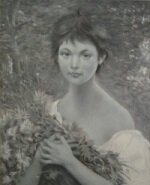
After flesh values are established, background values are laid in with bristle filberts. This part of the underpainting is applied thinly, allowing the warm tones of the initial rough-in to vibrate with the cool grays.
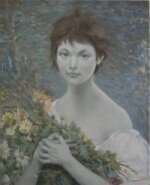
The initial color session includes a first pass at the background and the first glaze of the subject's hair. Then basic colors for the bouquet are established. Details and highlights will be added later.
Several factors determine a portrait commission rate. Although the size of the canvas is one factor, it is not necessarily true that a larger painting is priced higher. The primary factor affecting the cost of a commission is the amount of studio time that is required. Portraits that include a complex background or intricately detailed garments require considerably more studio time and therefore are priced higher. You will receive an exact quote during the initial consultation, when the composition is decided. Listed below are several options for portrait format. See the Original Portraits gallery for examples.
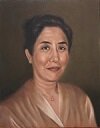 This is the simplest and most common format. Since the early Renaissance, numerous master artists have produced outstanding portraits, depicting only head and shoulders, similar to a sculptured bust. When the subject is clothed in a simple garment and placed against a neutral background, the entire focus of the portrait is on the subject's face.
This is the simplest and most common format. Since the early Renaissance, numerous master artists have produced outstanding portraits, depicting only head and shoulders, similar to a sculptured bust. When the subject is clothed in a simple garment and placed against a neutral background, the entire focus of the portrait is on the subject's face.
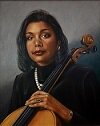 The half figure is an extension of the head-and-shoulders format, adding one or two hands to the portrait. Carefully rendered hands can contribute significantly to the subject's recognizable character. In some portraits, the subject's hand is shown holding an object that represents a certain achievement, profession, or social position.
The half figure is an extension of the head-and-shoulders format, adding one or two hands to the portrait. Carefully rendered hands can contribute significantly to the subject's recognizable character. In some portraits, the subject's hand is shown holding an object that represents a certain achievement, profession, or social position.
 Three-quarters or full-figure formats show most of the subject or the complete figure from head to toe, usually standing, sometimes seated. A full-length format often is used for a prestigious portrait of the subject in formal attire and may also include background imagery appropriate to the subject's profession or status.
Three-quarters or full-figure formats show most of the subject or the complete figure from head to toe, usually standing, sometimes seated. A full-length format often is used for a prestigious portrait of the subject in formal attire and may also include background imagery appropriate to the subject's profession or status.
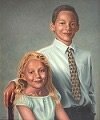 Group portraits can depict husband and wife, parent and child, siblings, or entire families. Additional figures may also be included in, for example, portraits of professionals where there is a significant connection between individuals. Group portraits may be arranged with some figures standing and others seated, in formal or informal settings.
Group portraits can depict husband and wife, parent and child, siblings, or entire families. Additional figures may also be included in, for example, portraits of professionals where there is a significant connection between individuals. Group portraits may be arranged with some figures standing and others seated, in formal or informal settings.
For a custom work of fine art and lasting value, you will find that commission rates of Portraits by Turner are both reasonable and competitive. Sales tax, framing and shipping charges are not included. Terms are 50% to start, 50% upon delivery of the finished work. For special quotes or additional information, please contact the artist. International clients: please see FAQ #17.
Commissioning an oil portrait is a unique way to recognize achievement, celebrate success, or treasure a remembrance. Dave Turner's paintings are crafted to show character and interest. The depth and luminosity of oil painting in general—and flesh tones in particular—cannot be matched in any other medium. With the traditional academic techniques that Turner uses, an oil painting can last beyond a lifetime; it can be preserved as a precious heirloom and as a work of fine art.
It depends on the size of the portrait, the amount of detail in the work, and other factors. For a custom work of fine art and lasting value, you will find that commission rates of Portraits by Turner are both reasonable and competitive. See Price Guide for details.
After a brief initial sitting, the canvas is painted from sketches and selected reference photographs, without the subject being personally present. A brief, final sitting may be necessary as the portrait nears completion. See The Portrait Process for more details.
Yes. The artist is available to travel nationwide for the initial consultation and sitting. He will return to his studio to complete the portrait. The process for long-distance clients is similar to the Portrait Process for local clients. Terms are 50% to start, with the remaining 50% due after you approve a photo of the finished portrait. The portrait will be shipped pre-paid by ground carrier. If you prefer, you may accept the extra charges of overnight and/or insured delivery.
In most cases, a head-and-shoulders portrait can be completed in about sixty days. Larger works and portraits that include intricately detailed elements require more time. The artist will state an estimated completion date on the signed Portrait Commission Agreement. Keep in mind that oil painting in general is a slow process. The Old Master technique that Turner uses involves many layers of carefully applied paint. One layer may take days to dry before the next layer can be applied. (See Glazing Technique.) With this traditional method of application, Turner produces high-quality, enduring works of fine art.
To capture the warmth and delight of young children, high-quality reference photographs are essential. During your consultation with the artist, he will make appropriate recommendations based on the age and personality of the child. See the Original Portraits gallery for an example of a toddler's portrait.
Turner prefers to work with human subjects, although he has been known to make exceptions. For example, a family group portrait may include a pet as part of the composition. See the Original Portraits gallery for an example of an unusual pet. See also the portrait "Lady in a Red Dress" in the Portrait Reproductions gallery.
Yes, this is quite possible if there are suitable photographs of the deceased. The process for a posthumous portrait is similar to the standard Portrait Process.
Minor corrections can be made as the work is close to completion. Significant changes are rarely necessary if sufficient time is taken at the initial consultation to reach a mutual understanding. Also, if the finished underpainting is carefully reviewed by the client, later corrections are seldom required.
Turner prefers to accept portrait commissions. In some portraits, it may be possible to include still-life elements in the composition, or a landscape in the background. Occasionally, Turner does non-portrait work (see Still Life & Landscape) paintings. Please check with the artist to discuss what you have in mind.
Turner's medium of choice is oil. Each medium requires special techniques that take time and skill to master. Turner has devoted his efforts to the oil painting techniques of the Old Masters. This is his specialty. He rarely works with pastels or watercolor.
Yes, Turner accepts portrait reproduction commissions, assuming the original artwork no longer has copyright attached. Turner's reproductions of master portraits are faithful to the original but are not stroke-for-stroke copies. For each reproduction, Turner adapts the original work to his own style and technique. See the Portrait Reproductions gallery for examples of how master portrait copies are rendered. The process for commissioning a portrait reproduction is similar to the process for commissioning an original portrait. (See The Portrait Process.)
The finished work can be delivered framed and ready to hang. Or you can choose to have the portrait framed yourself. At the artist's studio frame catalogues and samples are available in a variety of traditional and contemporary styles to suit the overall mood of the portrait in its final setting. (See The Artist's Studio.)
Turner received his art education in London, England and has painted in oils for over 30 years. He applies portrait techniques used by the Old Masters and couples these techniques with more modern methods and materials. Turner has developed a method and style of portraiture that satisfies clients with realism, characterization, and lasting value.
Throughout his artistic career, Turner has made careful and frequent first-hand study of master paintings in numerous galleries and museums worldwide (see Turner's Travels). By producing copies of selected master portraits (see Portrait Reproductions), Turner has acquired broad practical experience with the traditional academic techniques of previous centuries.
Turner has chosen not to compete for prizes or recognition, preferring instead to let the quality of his work speak for itself. He exhibits through the Internet rather than through gallery representation. This approach allows Turner to focus his time and artistic energy exclusively on painting. His client base is built up largely through referrals recommending his work.
No, but Dave is an admirer of the famous British painter's work. Dave especially likes his namesake's light-filled, atmospheric seascapes such as The Fighting Temeraire
No, that is not necessary. Turner prefers to work directly with his portrait clients, rather than use an artist's agent. For international clients, however, an agent may be needed for handling transaction documents. Please contact the artist for details.
Yes. Although Turner paints all portraits in his home studio, he travels internationally and is available worldwide for the initial consultation and sitting. The finished canvas is shipped prepaid and ready for framing. A local agent represents the artist and processes all necessary customs documents and fees. For further details, please contact the artist by e-mail.
Surveys show that American adults who use social media spend an average of 3 hours a day or more in this activity. Turner prefers to spend as much time as he can at his easel. He does, however, respond to e-mail and phone calls. For details, please see the Contact page.
Connecting all the golden ratio points of the four sides of a rectangle produces 42 straight lines within the rectangle. These lines intersect, making a total of 492 individual segments. By creative selection of appropriate lines and segments, together with balanced application of color and value, Turner builds an abstract design that represents a two-dimensional view of his chosen subject. See the Geometric Abstract Paintings gallery for examples.
Go to About the Artist / Turner's Music and play the music you want hear.